Today we’re going to talk about the 9 best tomatoes to grow in a pot and we’ve got a little something for everybody. Whether you want tiny tomatoes under an inch in size, flavorful mediums, or big beefsteak tomatoes, we’ve got a little something for everyone.
So, you’re craving tomatoes, but you’re a little short on space… what do you do? Well, we’re happy to say that you’ve come to the right place.
We’ll include information on the best soils to use, watering frequencies, useful measurements, and include a few useful tomato tips along the way. For good measure, we’ll even throw in a FAQ before we go, so if you’re ready, then let’s get started – it’s time to talk tomatoes!
Table of Contents
Best Tomatoes To Grow In A Pot
Small tomatoes – cherry tomatoes
Cherry tomatoes are a personal favorite of many, this author included. My grandfather always had them growing in the backyard, along with standard Romas, but the cherry tomatoes were always the ones that we looked forward to. Small, sweet, perfectly sized for salads without slicing – what’s not to love?
With that said, here are 3 that you can grow in a container so that you can start a little tradition of your own!
1. Micro Tom
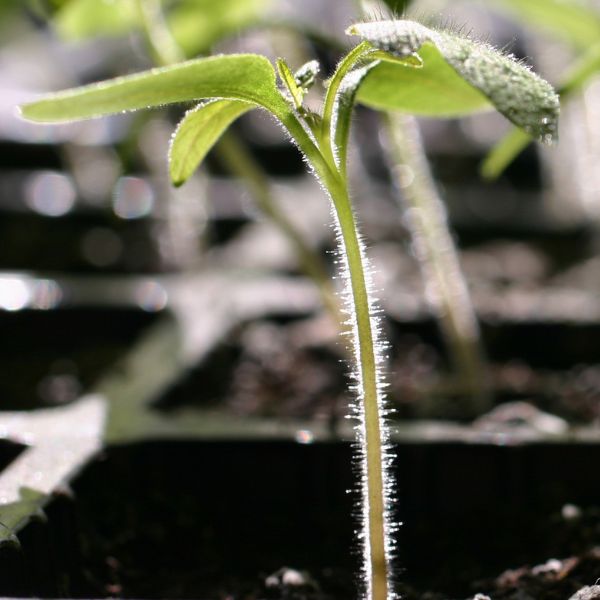
- Difficulty level – Beginner
- Scientific name – Solanum lycopersicum ‘Micro-Tom
Care and cultivation
Perfect for the patio at just 4 – 6 inches tall and 12-15 inches wide when fully grown, Micro Tom tomatoes are definitely a treat. They’ll start producing within 2 – 4 months and what you get are tiny tomatoes, 3/4 of an inch to 1 inch in size!
Tiny Toms will thrive in any well-draining soil and they need 4 to 6 hours of direct sunlight daily. Water them every 2 to 3 days, but only at the roots – watering the leaves can lead to leaf rot. Check the top 2 inches of soil with your finger each time before watering, as well. As long as it’s dry, it’s okay to water your Micro Toms and you’ll have the cute, sweet tomatoes in no time flat!
One final note – these tomatoes will need calcium added to their fertilizer for best results!
Pros
- Easy to raise
- Compact enough to grow on your balcony or even a desk by the window where they can get enough sunlight.
Cons
- The tomatoes are really quite tiny, which will delight some, but not necessarily everyone!
2. Black Cherry
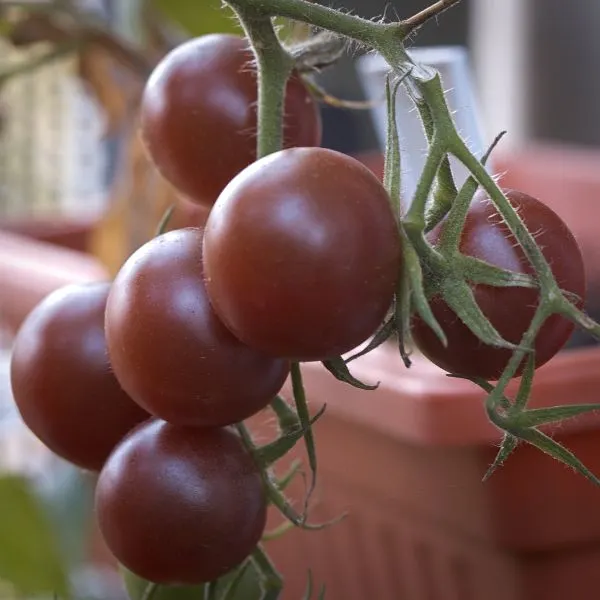
- Difficulty level – Beginner
- Scientific name – Lycopersicon esculentum ‘Black Cherry’
Care an cultivation
The ‘goths’ of the tomato world, Black cherry tomatoes grow in dark – looking rather like little plums! They’re quite sweet and flavorful, as well. While you’ll need a cage framework or a stake, these plants are a good fit for the balcony, as they’ll grow to be 4 to 5 feet tall and up to 4 feet wide. The violet tomatoes you’ll be getting measure around 1.5 inches.
Loamy or sandy soil is best for Black Cherries, with a little compost added, and they’ll need direct sunlight daily as well as watering every 2 to 3 days. As with Micro Toms, just check the top 2 inches of soil and you’ll know if your plant is thirsty or if you should wait another day. Be sure to fertilize 3 -5 times during the growing season, with compost tea and a nice, balanced liquid fertilizer being ideal.
Pros
- Aesthetically pleasing and flavorful tomatoes
- Produces large clusters of tomatoes
Cons
- Moderate watering required, but otherwise these are quite hardy.
3. Tidy Treats
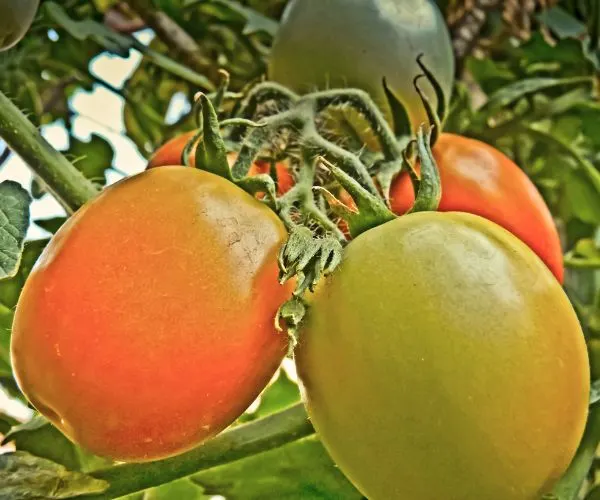
- Difficulty level – Beginner
- Scientific name – Lycopersicon esculentum ‘Tidy Treats’
Care and cultivation
Growing in at about 4 feet tall and producing tomatoes in as early as 2 months, Tidy Treats are a fantastic option that is really very easy to grow. You’ll want a support cage to help support them, but provided that you do this and take good care of your plant, you’ll have tasty 1 inch tomatoes in record time.
Tidy Treats like sandy or loamy soil (well-draining), along with full sunlight, and watering every 2 to 3 days when the topsoil is dry.
Pros
- Produces bountiful clusters of the cutest tomatoes you’ve ever seen
- Easy to raise and quite resilient against pests
Cons
- None that we’re aware of!
Medium-sized tomatoes
If you prefer a tomato with a little more heft, but not TOO much more, then these medium-sized tomato options will fit the bill perfectly. We’ve picked 3 favorites for you, so there’s a little something for everyone. Let’s take a peek and you’ll see for yourself!
4. Better Boy
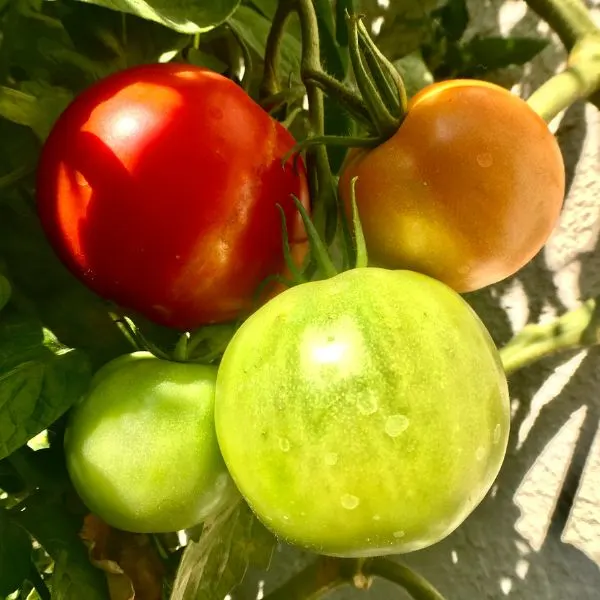
- Difficulty level – Beginner
- Scientific name – Solanum lycopersicum ‘Better Boy’
Care and cultivation
Growing up to be approximately 6 feet tall and 2-3 feet wide when fully grown, Better Boy tomatoes will do well in a 16 to 18 inch container, with a stake to help guide them up towards the sun!
These plants are quite hardy and productive, producing your first ripe tomatoes within 60 to 70 days and what’s more, you can get about 30 – 50 of them if you’re lucky (although look to the low end with a container plant, as it’s gotta work with available space!).
A sandy loam soil is best for your Better Boys, along with 6 hours of full sunlight daily, and they need about an inch of water every week – this comes out to watering once or twice every week and be sure to water at the roots only. Host your plant in a 36 inch container, 24 – 48 inches deep.
Pros
- Robust and quite manageable when grown in a container
- You’ll get LOTS of tomatoes
- Only 2-3 feet wide, so you can plant a buddy for your first Better Boy if you like
Cons
- No cons to these – they are bestsellers and one of the most popular U.S. varieties around!
5. Plum Regal
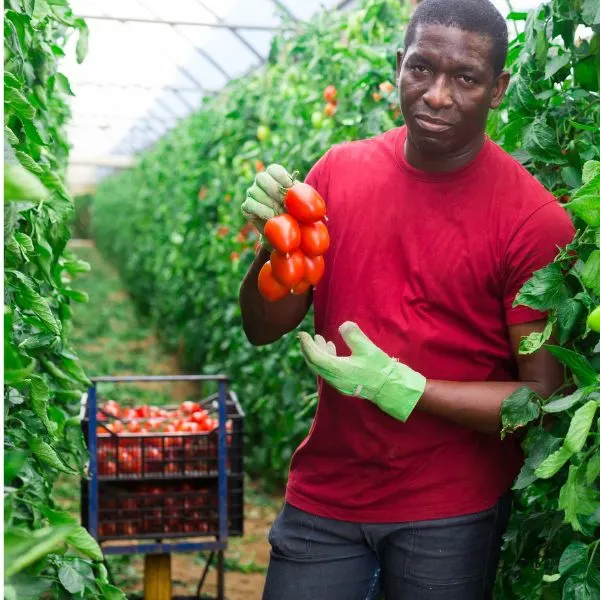
- Difficulty level – Beginner
- Scientific name – Lycopersicon lycopersicum ‘Plum Regal’
Care and cultivation
Plum Regal tomatoes are ovoid in shape and fit well in the ‘small to middling’ tomato sized category. They’re also quite good so whipping up a memorable tomato paste – just in case you were wondering!
Measuring in at 4 feet tall, these babies are tolerant to early and late blight, making them easy to care for if you haven’t had the best of luck with your tomatoes.
Expect a high yield within 75 days and be sure to plant your Plum regals in a rich, loamy soil, and adding a little compost and mulch is also a good idea to help keep it fertile and moist.
For this plant, rather than a set schedule, test the top 2 inches of soil for dryness and water when you find it – you’ll learn your plants’ preferred schedule naturally this way.
6 hours of full sunlight is best for these plants and during the growing season, a nice liquid fertilizer every 7 to 10 days will yield best results.
For your container, go with a large, 18 – 36 inch container, at least 24 inches deep.
Pros
- If you like making homemade paste or salsa, you’re in for a treat
- Blight tolerant, they’re hard to kill, and that’s never a bad thing.
Cons
- A little extra work when compared to some of the other options, but well-worth the effort.
6. Tigerella tomatoes
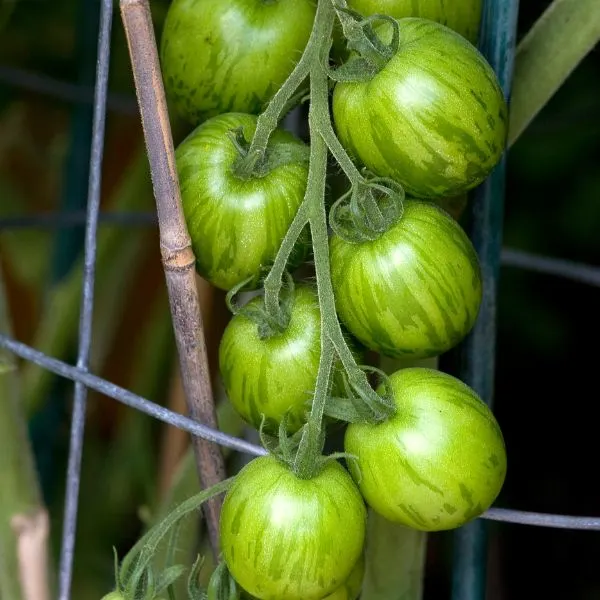
- Difficulty level – Beginner
- Scientific name – Solanum lycopersicum ‘Tigerella’
Care and cultivation
Tigerella tomatoes taste delicious and they bring quite the aesthetic to your balcony or porch with their yellow striped outsides. They will grow up to 7 to 8 feet tall, so you’ll need a stake or cage, and your container should ideally be 18 to 36 inches wide, 24-48 inches deep.
Pros
- It’s always nice when something tasty also happens to be beautiful, and the exotic look of Tigerellas does not disappoint.
- The taste is unique, just like the look – these tomatoes are both sweet and tart
Cons
- These are thinner skinned, so they will bruise or crack easily if you’re not careful or unlucky. Just a heads-up!
Large tomatoes
Now that we’ve covered the small and medium varieties, it’s time to take a look at the big boys! These tomato plants will produce large, delicious tomatoes, and you’d be amiss if you didn’t take advantage by treating yourself to a traditional, half-sliced and salted one fresh from your balcony or porch!
Without further ado, let’s look at these 3 varieties of big ol’ tomatoes!
7. Brandywine tomatoes
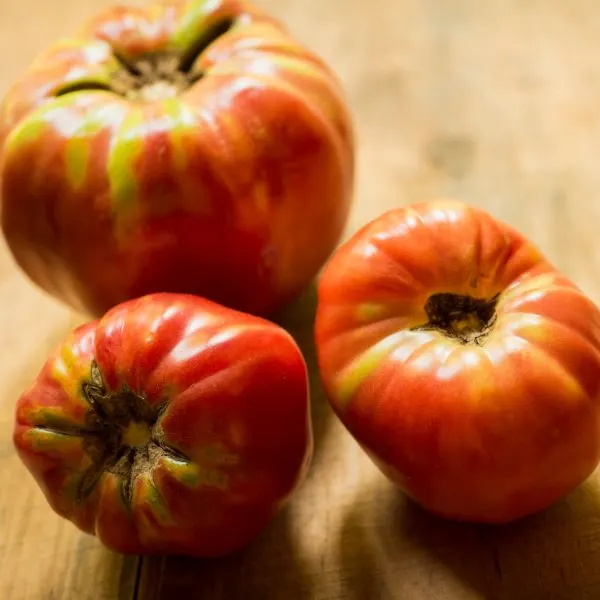
- Difficulty level – Beginner to Intermediate
- Scientific name – Solanum lycopersicum ‘Brandywine’
Care and cultivation
Thick and flavorful, Brandywine tomatoes are beefsteak beauties that you can grow in a medium to large sized container and which you are sure to love.
Did we mention that they also come in pink, yellow, and black?! As far as height and width, they can grow as high as 9 feet unchecked, but you can easily whittle that down with careful caging, and expect about a 3 foot spread.
Loamy soil is best, but if you’re experienced, add a little clay to make things just about perfect. As long as it’s well-draining, they’ll need about an inch of water every week (1 to 2 waterings when the topsoil is dry) and about 6 full hours of sunlight daily.
Maturation time is around 100 days, but you won’t be disappointed – you can get tomatoes that weigh 1.5 pounds from these plants and who doesn’t like that?
Pros
- Large, heavy, and flavorful tomatoes in 3 different colors so that they’ll add to the aesthetic appeal when grown in groups
- Superb flavor and a long shelf life, just in case you feel like canning or ‘saucing around’
Cons
- Shape isn’t always perfect, but the flavor and heft more than make up for it
8. Celebrity tomatoes

- Difficulty level – Beginner
- Scientific name – Solanum lycopersicum ‘Celebrity’
Care and cultivation
Perfectly red and round tomatoes approximately 4 inches across are what you get when you grow Celebrity tomatoes. Add in that each plant tops out at about 4 feet tall, these beauties also won’t take up much space at all! Containers should ideally be 12 inches wide and 12 inches deep – piece of cake!
Well-draining, sandy loam soil is the best for these beauties and you’ll want to make sure that they get at least 6 hours of full sunlight, as well.
These tomatoes need about 1 inch of water every week, just check the topsoil and if it’s dry, then it’s ready to water. This is typically once or twice a week, or you can get fancy and add a drip waterer and just fill that, as-needed!
Pros
- Compact tomato plants that produce deeply colored, perfectly rounded tomatoes within 0 to 5 days.
- Easy to care for, especially if you do the ‘drip’ route
- Disease and pest-resistant
Cons
- None that we’re aware of!
9. Container’s choice red
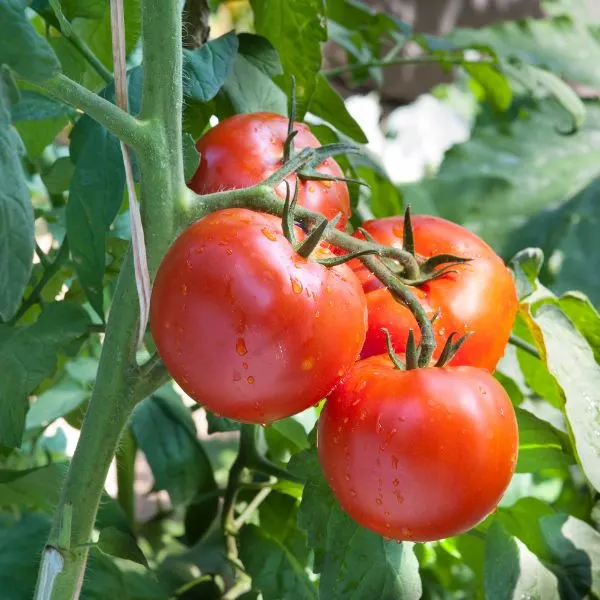
- Difficulty level – Beginner
- Scientific name – Solanum lycopersicum ‘Container’s choice”
Care and cultivation
Designed to be compact, Container’s choice tomato plants can be anywhere from 18 to 48 inches tall, and yield delicious 5-8-ounce tomatoes within 63 to 70 days.
They’re perfect for your patio, balcony, or porch, and while you don’t need a stake for them, they will benefit from one if you decide to provide it.
The BEST soil for Container’s Choice tomatoes is an equal mix of sand, compost, and clay, and give it full sunlight along with watering whenever the top 2 inches are dry (typically twice a week, but check the soil first to avoid overwatering). The ideal container should be 24 inches deep and at least 20 inches across.
Pros
- Quite ornamental and easy to fit just about anywhere – probably the most svelte selection on the list.
- Resistant to early and late blight
Cons
- None – these are about as optimized for small space and big tomatoes as you can get!
FAQ
Before we get to the conclusion phase of this article, we’ve collected some useful frequently asked questions that can help to ensure that your tomatoes grow tall and lovely, without a lot of worry involved. Let’s take a peek!
How much space do container tomatoes need?
Small tomato plants can usually be grown in containers as tiny as 12 inches wide and 12 inches deep, but usually it’s best to go with 24 inches wide and 24 inches deep if you aren’t sure.
This will usually work fine, although with larger tomato plants we recommend that you double check with someone at your local nursery or online.
What do you put in the bottom of a tomato container?
The standard is usually a mix of ¾ potting soil, with the remaining ¼ of your mix being a 2-3 inch layer of gravel.
Tomatoes are pretty hardy, and while most of them prefer sandy loam type soils, they’re not as picky as other plants as long as the soil is well draining and they’re getting a little fertilizer during their growing season.
Why are my container tomatoes rotting on the bottom?
This condition is called ‘blossom-end rot’ and you’ll see this from time to time when it’s really dry out.
The root cause is actually calcium deficiency, and the easiest fix is going to be simply saving eggshells when you make breakfast so that you can crush them up and put them directly on the soil.
Your plant will absorb the calcium with subsequent watering and this should help to prevent bottom rotting in the future.
Why are my container tomato leaves curling?
Curling leaves may result from insect infestations or from drought conditions. In the former case, treatment options will vary based on the type of pest, but with the latter your best defense is to water thoroughly when the top 2 inches of soil is dry, making sure that you add enough water that you can see the excess draining out of the pot below.
Can I sprinkle Epsom salt around my tomatoes?
While some gardeners recommend this, we don’t, and we’ll tell you why. Epsom salt is not something that your plant can use, so it’s not going to absorb it on purpose, and that same salt can end up in the groundwater when it drains.
Worse, Epsom salt can actually promote blossom-end rot, and you definitely don’t want that! Stick to your favorite fertilizers during the growing season and leave that Epsom salt in the container where it belongs.
Some closing words on the best tomatoes to grow in a pot
There’s nothing quite like having fresh tomatoes and if your space is limited, that’s no excuse! With the 9 varieties that we’ve discussed today, you’ve got options that will fit just about any available space. From Micro Toms that you could host next to a window indoors, to balcony beauties such as Celebrity tomatoes or Brandywines, all you’ll need to do now is to pick your favorites and get them planted.
Within 70 to 100 days, you’ll be producing your own tomatoes, and once you taste them then you’re never going back to store-bought – the difference really is like night and day.
Until next time, we wish you and your new tomatoes the very best!
More plant stuff
- Best mulch to use to prevent termites
- Is a raised bed better than an in ground garden?
- Difference between palm trees and coconut trees
- Best potting soil for blueberries
- How far apart should tomato plants be planted
- How long does a tomato plant live
- Common types of tomato worms
- Best companion plants for tomatoes
- Why you should not plant tomatoes near cucumbers
- Best tomatoes to grow in pots
